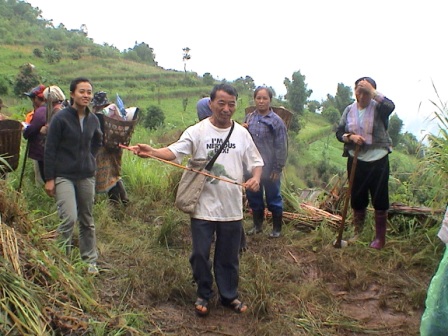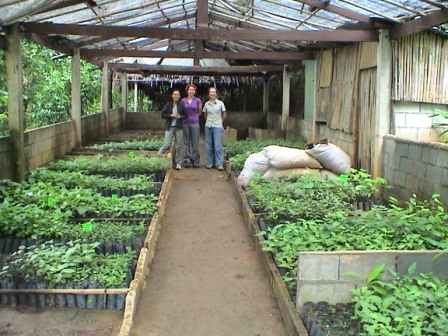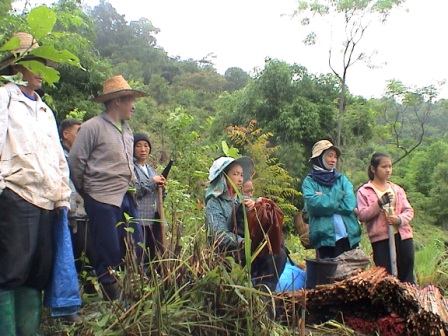Overview
The Forest Restoration Research Unit (FORRU), from northern Thailand’s Chiang Mai University, is conducting an ongoing research and restoration project in Doi Suthep-Pui National Park. Researchers are working together with local villagers to transplant nursery-reared seedlings into a stand of severely degraded seasonally dry tropical forest and to conduct investigations aimed at improving the efficiency and effectiveness of forest restoration techniques. FORRU’s unique approach, called the framework species method, involves the selection of 20-30 tree species that grow quickly, exhibit high rates of survival, produce dense canopies to shade out weeds, and yield fruits and flowers attractive to seed-dispersing fauna that carry seeds of other forest species onto the site. By planting these framework species, researchers have shown that the process of natural regeneration can be greatly accelerated and the likelihood of the restoration’s ultimate success can be considerably improved.
Quick Facts
Project Location:
Doi Suthep-Pui National Park, Chang Phueak, Mueang Chiang Mai District, Chiang Mai, Thailand, 18.8256393, 98.89450399999998
Geographic Region:
Asia
Country or Territory:
Thailand
Biome:
Tropical Forest
Ecosystem:
Tropical Forest - Moist Broadleaf, Tropical Forest - Coniferous
Area being restored:
3.2 hectares
Project Lead:
Forest Restoration Research Unit (FORRU), from northern Thailand's Chiang Mai University
Organization Type:
University / Academic Institution
Location
Project Stage:
Implementation
Start Date:
1996-08-14
End Date:
1996-08-14
Primary Causes of Degradation
Agriculture & Livestock, DeforestationDegradation Description
The site targeted by this project had been covered with evergreen forest and had been cleared approximately 30 years previously in order to provide land for the cultivation of cabbages, corn, potatoes and other cash crops. Cultivation of most of the site was gradually phased out from 1996, although a small part of the site had remained cultivated for corn until 2004. Fires had also affected parts of the site in 1998 and 2003.
The abandoned fields were dominated by herbaceous weeds such as Pteridium aquilinum (L.) Kuhn (Dennstaedtiaceae), Bidens pilosa L. var. minor (Bl.) Sherf, Ageratum conyzoides L., Eupatorium odoratum L. and E. adenophorum Spreng. (all Compositae), Commelina diffusa Burm. F. (Commelinaceae) and grasses e.g. Phragmites vallatoria (Pluk, ex L.) Veldk., Imperata cylindrica (L.) P. Beauv. Var. major (Nees) C.E. Hubb. Ex Hubb. & Vaugh. and Thysanolaena latifolia (Roxb. ex Horn.) Honda (both Gramineae). Most of the slopes below the plots are still cultivated for corn, carrots and some upland rice, with lynchee orchards beyond, providing the villagers with their main source of income.
A few remnant trees remained sparsely scattered across the plot, but had not fostered substantial natural regeneration. The nearest patch of forest was about 4 km east from the plot. In general, soils in the deforested zone, analyzed in 2000 (Elliott et al., 2000), were significantly more acidic and contained significantly less organic matter and nitrogen, more sand and less silt and clay, when compared with undisturbed forest.
Generally speaking, tropical forest destruction represents a major threat to the seasonally dry forest of Southeast Asia’s highlands. The loss of this forest precipitates other detrimental impacts such as the degradation of water catchments, the loss of biodiversity and the worsening of rural poverty. The seasonally dry tropical forests of Southeast Asia’s monsoonal belt are thought to be more endangered than equatorial rainforests.
In response to this growing threat, several countries in the region have banned or restricted commercial logging in remaining areas of primary forest and have added former logging concessions to their already extensive systems of protected areas. In spite of these measures, the problem now is that even these so-called “protected” forests are often too degraded to meet the need for healthy, natural forest that is capable of supporting viable populations of wildlife. It is becoming increasingly apparent that attempts to protect remaining forest are not enough; destruction must not merely be halted, but actually reversed, if there is any hope of saving Southeast Asia’s tropical forests.
Reference Ecosystem Description
The major forest types represented in Doi Suthep-Pui National Park include the deciduous forest associations of the lowlands (deciduous dipterocarp-oak, bamboo deciduous forest and mixed evergreen deciduous forest) and the evergreen forest of the uplands (sensu Maxwell & Elliott, 2001). The study area supports at least 493 of the 645 total tree species recorded in the park.
Project Goals
There are two primary aims of this project. The first is to conduct research in order to develop ecologically sound and socially acceptable methods for accelerating the regeneration of natural forest ecosystems on degraded land within protected areas of Northern Thailand. The second aim is to undertake education programmes, based on knowledge generated from the research, to enable local people to improve forest restoration projects for biodiversity conservation, environmental protection and enhancement of human well being.
Monitoring
The project does not have a monitoring plan.
Stakeholders
Demand for the information generated by The Forest Restoration Research Unit (FORRU) has become overwhelming. Researchers and project participants are disseminating key findings and management practices to a wide range of groups/individuals involved in forest restoration through a complementary project, “Education and Training for Restoring Tropical Forest Biodiversity in Thailand,” funded by Britain’s Darwin Initiative. This program is helping to build local capacity for accelerating natural regeneration and is providing new skills to improve forest restoration techniques and biodiversity monitoring practices. In fact, one of the project’s major outputs will be the publication of a definitive manual, detailing the best techniques to restore forest ecosystems for biodiversity conservation.
Description of Project Activities:
The FORRU's research program has concentrated on four main areas:
i) development of criteria by which framework tree species are selected
ii) improved techniques to grow framework tree species in nurseries
iii) improved techniques to maximize performance of trees after planting
iv) monitoring the return of biodiversity in planted plots
The essential ecological characteristics of framework tree species are: high survival when planted out in degraded sites; rapid growth; dense, spreading crowns that shade out herbaceous weeds; and flowering and fruiting (or provision of other resources) attractive to wildlife at a young age. In the seasonally dry tropics, where wild fires are an annual hazard during the dry season, an additional desirable characteristic of framework species is resilience to burning. When fire prevention measures fail, the success of forest restoration plantings can depend on the ability of the planted trees to re-sprout from their rootstock after fire has burnt their above-ground parts (i.e. coppicing). The essential nursery characteristics of framework species include; reliable seed availability; rapid and synchronous seed germination; and production of healthy seedlings in containers, preferably to a plantable size (40-60 cm) in less than 1 year. High quality seedlings are important, as they have the best chance of surviving in hostile deforested environments. Consequently it is essential that good horticultural practices are adopted.
For the purpose of this project, a research nursery was established at the National Park headquarters and a community tree nursery was built at the Hmong hill-tribe village of Mae Sa Mai, in collaboration with the village's grass roots conservation group. Experimental field plots were also planted near the village.
In the nursery, experiments were designed to develop horticultural practices that optimize seedling vigor and health (Blakesley et al., 2000). Germination trials were carried out on more than 400 native forest tree species (Blakesley et al., 2002). Some species germinated easily, whilst others proved difficult, and thus, various treatments to break dormancy were tested (Kopachon, 1995; Singpetch, 2001). For those species that proved impossible to germinate, vegetative propagation from cuttings and the rearing of seedlings dug up from the forest (Kuarak, 2002) were also investigated. Experiments were then conducted to determine the best container types and media for seedling growth and survival (Zangkum, 1998; Jitlam, 2001) and to develop production schedules for promising tree species (Kuarak et al., 2000; Elliott et al., 2002; Blakesley et al., 2000). The aim was to develop treatment combinations to produce trees of a plantable size and quality by the first or second planting season after seed collection.
Trees were then planted in field trials to assess the relative performance of various "potential" framework species (Elliott et al., in press). Survival and growth were monitored, as well as ability to shade out weeds and resilience to fire. Various silvicultural treatments, to enhance performance of the planted trees, were also tested. These included different weeding methods, mulching and fertilizer application regimes (Elliott et al., 2000). An essential characteristic of framework tree species is attractiveness to seed-dispersing wildlife. Therefore, planted trees were checked regularly for production of any resources that might attract birds or mammals (e.g. fruits, flowers etc.). Surveys to assess the species richness and composition of the ground flora and bird (Chantong, 1999) and mammal communities were also carried out.
Candidate framework species were initially selected from amongst a local tree flora of more than 600 species by consulting CMU's existing Herbarium database, nursery research on seedling and by pilot planting trials in 1995-1997. From 1998, experimental plots have been established annually in partnership with a Hmong hill-tribe community resident within DSPNP. FORRU helped the villagers to establish their own community tree nursery and to test the practicability of the new nursery methods developed in the research nursery in a village environment. The planting trials had three main objectives: i) to provide a quantitative assessment of the degree to which various tree species meet framework species criteria; ii) to test various silvicultural treatments to maximize field performance and iii) to monitor biodiversity recovery. As the more successful species and techniques have been adopted and less successful rejected, the success of these experimental plots has gradually improved.
Using the findings from these investigations of potential framework species, FORRU conducted a planting of 4,010 tree saplings over approximately 3.2 hectares in August 2006. The planted saplings represent 46 species of proven value as framework species, plus a few species--e.g. Acer laurinum, Carallia brachiata, Podocarpus neriifolius, etc.--planted for conservation purposes, as they are considered to be rare or threatened with extirpation from the national park. Some of the trees had been grown from locally collected seed by the villagers themselves in their community tree nursery, while the rest were transported to the site from FORRU's research nursery at the HQ of the National Park. Trees had been grown for 6-18 months (depending on species) in 9 x 2 ½ inch plastic bags in a medium of forest soil: coconut husk: peanut husk, 2:1:1 with slow release fertilizer (Osmocote 3 months) applied as required.
The actual planting was conducted in several steps. First, the area was surveyed for any of the trees planted in 2005 which had survived under the weeds. The survival rate was higher than initially expected, estimated at about 60-65%, but survival was very variable and patchy across the site, with more trees surviving along the northern and eastern sides of the site and very few in the middle and at the southern end. Bamboo stakes were placed by each surviving tree to make sure that they were visible and not damaged during site clearance and planting operations. Then the site was cleared of weeds by slashing them down to ground level. The place where each tree was to be planted was marked by 50-cm tall bamboo stakes. The stakes were placed randomly across the site, roughly 1.8 m apart, to create a natural looking layout to the restored forest. The saplings were loaded into baskets and distributed to each of the stakes. Beside each bamboo stake, a hoe was used to dig a hole, approximately twice the volume of the plastic bags in which the trees had been grown. The hoe was also used to dig out the weed roots in a circle 50-100 cm in diameter around the hole. The plastic bags were slashed with box cutters to remove the saplings without damaging the roots. Then the saplings were placed upright in holes. The space around the root ball was packed with loose soil, making sure that each sapling's root collar was eventually positioned level with the soil surface. Fifty grams of fertilizer (Rabbit brand, N P K 15-15-15) was then spread in a ring on the soil surface, about 10-20 cm away from the sapling stem. Finally, dead weeds were placed around each planted tree as mulch.
Ecological Outcomes Achieved
Eliminate existing threats to the ecosystem:
Monitoring to assess immediate post-planting mortality of trees planted in August 2006 has already been carried out, and the data are being analyzed. Initial results indicate zero mortality for most trees planted in 2006 and low mortality for the rest, including: Aquilaria crassna, Eugenia fruticosa, Ficus fistulosa, Magnolia baillonii, Nyssa javanica and Prunus cerasoides (all 4% mortality); Vitex quinata (8%) and Spondias axillaris (16%). This mortality may have been due to transplantation shock and to rough handling during transportation and planting and also due. Average density of trees planted in 2006 (surviving in 10 circular sample units (10 m in diameter) placed regularly across the site) was 17.6 (SD 7.47) which is equivalent to 359 trees per rai (1 rai = 0.16 ha). Trees surviving from previous plantings, as well as scattered, naturally-established trees, increased this density well above the required 500 per rai required for rapid canopy closure.
One of the most important outcomes of FORRU's research has been the identification of those species that can rapidly restore forest structure and function, while simultaneously enhancing natural forest regeneration and biodiversity recovery. The project has shown that forest cover can now be returned to highly degraded forestland (at 1,300 m elevation) within 3-4 years. Canopy closure starts to occur by the end of the second year after planting and is nearly complete by the end of the fourth. Weeds are shaded out and leaf litter starts to accumulate, re-establishing nutrient cycles. The trees attract seed-dispersing bird species resulting in the establishment of additional (non-planted) tree species and a gradual return to the tree species composition of the original forest.
Socio-Economic & Community Outcomes Achieved
Key Lessons Learned
The framework species approach proved to be suitable to restore evergreen forest at higher elevations in Southeast Asia. FORRU’s immediate priority is to extend this approach to the restoration of northern Thailand’s deciduous forest ecosystems at lower elevations.
Despite the success of this approach, further research on the diet and general ecology of seed-dispersing animals would help streamline the selection of framework tree species. The relationship between insects in planted plots and seed-dispersing birds and mammals is another topic in need of further investigation. Research thus far has indicated that the trees species most likely to attract these animals produce small to medium-sized fleshy fruits (e.g. Callicarpa arborea, Ficus semicordata, F. subulata, Phoebe lanceolata, Prunus cerasoide,) or flowers with copious quantities of nectar (e.g. Erythrina subumbrans) less than 4 years after planting. Tree species used by birds as nesting sites within 4 years after planting include: Balacata baccatum, Erythrina subumbrans, Eugenia albiflora, Ficus subulata , Ficus glaberima, Ficus semicordata, Helicia nilagirica, Hovenia dulcis, Prunus cerasoides, Quercus semiserrata, Rhus rhetsoides, and Turpinia pomifera.
Long-Term Management
Monitoring will be ongoing, as will weeding and fertilizer applications.
Sources and Amounts of Funding
FORRU’s core research program is currently sponsored by the Biodiversity Research and Training Program (a Thai Government fund) and Britain’s Eden Project. Planting activities conducted in August 2006, along with follow-up monitoring, weeding, fire prevention and assessment, were funded by a grant from the Plant-A-Tree-Today Foundation (PATT). PATT also provided a small grant to support Baan Mae Sa Mai village.
Other Resources
Forest Restoration Research Unit (FORRU)
http://www.forru.org/home.htm
Doi Suthep-Pui National Park
http://www.dnp.go.th/parkreserve/asp/style2/default.asp?npid=53&lg=2




